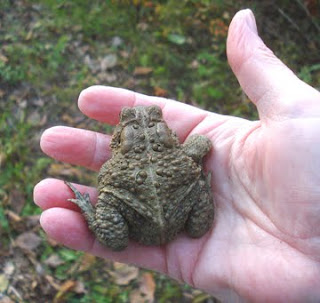After the recent snow and rain, Tom and I couldn't resist going out for a walk on the Chippewa River trail. We dodged puddles and watched for birds. White-throated Sparrows, American Robins and flocks of very noisy Cedar Waxwings.
I was surprised by an unseen and unexpected bird that exploded out of the wetlands - a Wilson's Snipe.
Further down the trail where I found that green frog a while ago, I got to thinking about how amazing it is - that reptiles and amphibians hibernate. They just know where to go, when to dig and how to do it. No free will. They just do it.
I started to practice my tree identification skills, paying attention to the leaves still holding on the trees and shrubs. I wasn't looking at the fallen leaves on the trail. Then Tom shouted - watch out - don't step on it!
What?
I stopped and looked down. All I saw were leaves.
Then Tom pointed - and I finally saw it ...
Would it wait for me to pull out my camera?
Yep. I took a bunch of photos, then picked him up (no insect repellent on my hands today).
These toads have two large glands behind their eyes that secrete bufotoxin which can irritate human skin. If you handle a toad, don't rub your eyes or stick your hands in your mouth before you wash your hands. The milky secretions can make small mammals sick if they try to eat one.
American toads eat small invertebrates - crickets, ants, slugs and spiders. One toad can eat an amazing number of insects - up to 1,000 a day. A great reason to install a water garden to attract them.
Toads don't drink water, they absorb it through their skin.
This guy was male (dark throat). Females have a light throat.
While they're small and growing, these toads shed their skin a couple of times a month. When they're mature, they shed their skin about 4 times a year - all in one piece. Then they eat it.
They may live up to ten years in the wild, if they get past the tadpole stage. Toad tadpoles also have the toxins. Predators quickly learn to avoid them, with the notable exception of Hognose and Garter snakes.
In the spring, males set up breeding territories. They are noted for their spring calls - a sustained high musical trill.



No comments:
Post a Comment